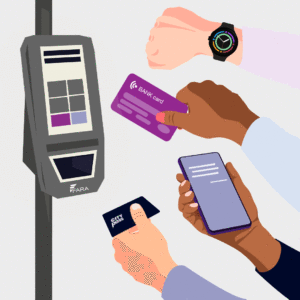 The way we pay for goods and services has changed radically over the past 20 years, and the transition away from cash solutions has accelerated during Covid. With work, travel and payment habits altering, public transport must also adapt.
The way we pay for goods and services has changed radically over the past 20 years, and the transition away from cash solutions has accelerated during Covid. With work, travel and payment habits altering, public transport must also adapt.
The introduction of contactless payments has changed the way people buy most things – from paying for a coffee, through to going out for lunch, and even grocery shopping. It’s easy. It’s quick. It’s simple.
Across the world, contactless transactions with cEMV are predicted to increase by over 1,700% [source: Juniper Research, via Statista] in the next two years. People are now able to pay for almost everything with a card or device which is always ready and waiting in your bag, pocket or on your wrist.
Public transport has also, to an extent, joined the revolution with a lower amount of cash transactions taking place and with the introduction of several new contactless payment options. Where public transport perhaps hasn’t kept pace is offering passengers the opportunity to pay with contactless bank cards.
cEMV: Fit for new travel habits
The number of people travelling via public transport dropped significantly in the Nordics due to Covid, with Sweden losing 90% of passengers overnight [source: IRU – The World Road Transport Organisation]. Across the world, this led to a subsequent shift to working from home, and research shows that hybrid working is, for many, the preferred option in the long-term. The industry is now being challenged on the traditional ways of operating.
It is clear that due to their changing travel habits, passengers have lost the incentive to pre-purchase a ticket, but still want discounts based on their actual travel. cEMV meets this current and future demand.
The big question around cEMV
Our report will help guide you through how contactless ticketing is paving the way for the future of public transport and gives you answers including:
 Getting back to basics: What is contactless ticketing and cEMV?
Getting back to basics: What is contactless ticketing and cEMV?- Types of pricing: Fixed price, best price or pre-paid?
- The important bit: The key benefits of contactless ticketing
- National standards and contactless: The perfect match
- How it’s fit for new travel habits: Covid recovery
- Why it’s here to stay.

